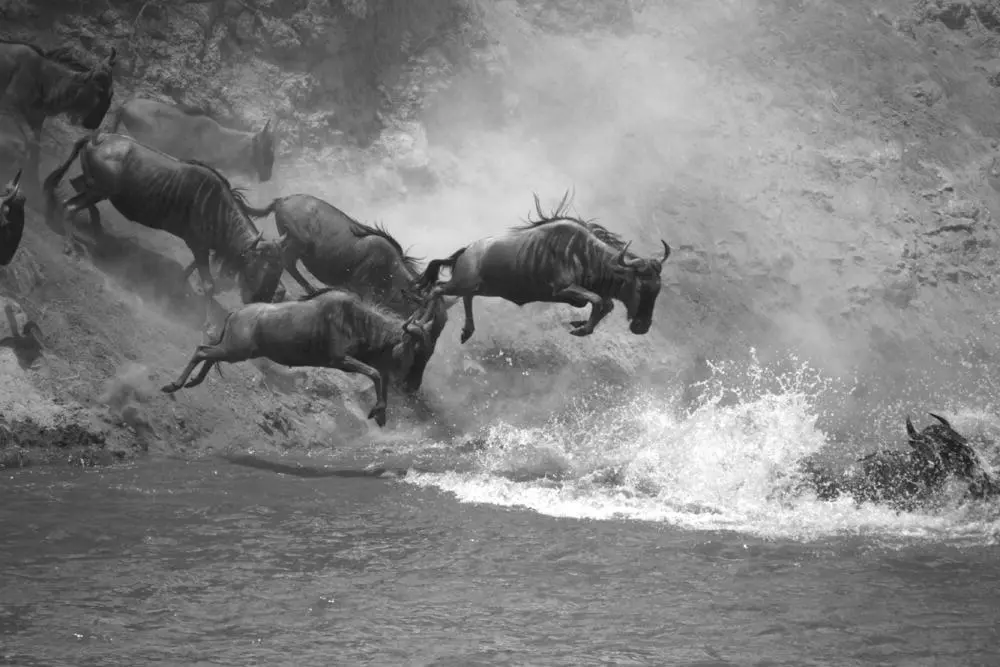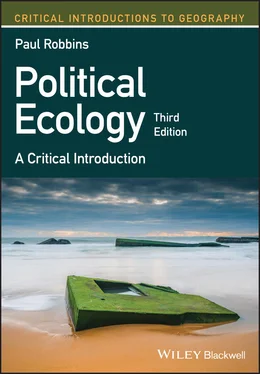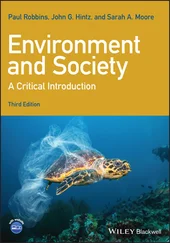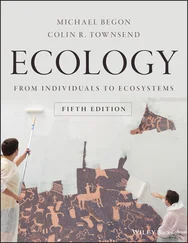Each of the chapters in this section also includes case histories of how, in my own work, I have tried to do research, and how on many occasions I have been tripped up by hidden pitfalls. These sections only reflect what I have done in research rather than what political ecologists have done more generally, but I think my methodological choices are not unique and the problems I have faced are common not only to political ecology, but also to much research in general.
The conclusions in Part IV will critically evaluate the status of the field and point to ways political ecology can expand and improve. My central argument here is that political ecology must attend to the future, by imagining new alternatives based either on the promises of degrowth or on a kind of emancipatory and modest modernism, all the while breaking loose from both the apocalyptic and green utopian imaginaries that otherwise hold the future captive.
Scattered throughout the text are boxed critical summaries of important individual contributions to political ecology and the people who made them. These are based on my own reading, but wherever possible these also include direct reflections and responses from those authors kind enough to provide them.
The sum of the effort can only be said to give the reader a “feel” for a field of practice that certainly has come to be influential and whose reach has crossed many social and environmental sciences. Curiously, however, for a field of this stature, it seems odd that political ecology is so hard to define! We first must attend to why this might be so.
Chapter 1 Political versus Apolitical Ecologies
What is Political Ecology?
Five Dominant Narratives in Political Ecology
For many of us who are unable to travel to the plains of East Africa, our images of the region are given life on late‐night cable wildlife television, in bold IMAX presentations at natural history museums, or perhaps in the vivid spectacle of Disney's The Lion King . The imagined patterns of the “circle of life” in these media – complete with lions, hyenas, and baboons – play out on a yellow‐filtered savanna where migrations of wildebeest cross the Serengeti, chasing seasonal rainfall, hunted in turn by stoic predators. The scenes are compelling and they inspire in us a justifiable affection for the beauty and complexity of the non‐human world around us. These images are also ecologically important, since they give us a picture of connectedness, which is essential to understanding life on the savanna. Across the borderlands of Kenya and Tanzania forage grasses follow rainfall, wildebeest pursue forage, predators pursue wildebeest, scavengers pursue predators, and so on.
The absence of people from these imaginary landscapes seems in no way strange for most of us; these are natural landscapes, apparently far from farms, factories, and the depredations of humankind. It is perhaps inevitable, therefore, that an intuitive reaction to the news that wildlife populations are in crisis – including declines in giraffe, topi, buffalo, warthog, gazelle, and eland – is to imagine that the intrusion of humankind into the system is the cause of the problem. Growing populations of impoverished African people, we might imagine, have contaminated the natural rhythm of the wilderness. Indeed, the sense of loss in contemplating the declining biodiversity and destroyed landscapes may inspire frustration, coupled with a feeling of helplessness; the situation in the Serengeti and the steady march of growing populations seem far beyond the control and influence of life where we live ( Figure 1.1).

Figure 1.1 Wildebeest crossing the Mara River in Kenya. The migration of wild animals across the region occurs amidst a fully humanized and highly political environment.
Source: Photo © Paul Banton/Shutterstock.
Stepping back from the savanna, however, and gazing across the Serengeti–Mara ecosystem both in time and in space, habitat loss and wildlife decline appear more complex and more connected to the daily lives and routines of urban people in the developed world. A cross‐border analysis shows that the decline in habitat and wildlife in Kenya is far higher than that in Tanzania. Why? Rainfall, human population, and livestock numbers do not differ significantly. Rather, private holdings and investment in export cereal grains on the Kenyan side of the border have led to intensive cropping and the decline of habitat. These cereals are consumed around the world, as part of an increasingly globalized food economy. As Kenya is increasingly linked to these global markets and as pressure on local producers increases, habitat loss is accelerated. Less developed agricultural markets and less fully privatized land tenure systems in Tanzania mean less pressure on wildlife. The wildlife crisis in East Africa is more political and economic than demographic (Homewood et al. 2001).
These facts undermine widely held apolitical views about ecological relations in one of the most high‐profile wildlife habitats in the world. They also point to faulty assumptions about the nature of “wild” Africa. First, the image of a Serengeti without people is a fallacious one. The Masai people and their ancestors inhabited the Central Rift Valley for thousands of years before European contact, living in and around wildlife for generations. Indeed, their removal from wildlife park areas has led to violent conflicts (Collett 1987). More generally, the isolation of these places is also a mistaken perception. Export crops from Kenya, including tea and coffee in other parts of Kenya beyond the Central Rift Valley, continue to find their way to consumers in the first world, even as their global prices fall, constraining producers who must increase production, planting more often and over greater areas, further changing local ecological conditions. With three‐quarters of the population engaged in agriculture, economic margins for most Kenyans become tighter every year, and implications for habitat and wildlife more urgent.
The migration of the wildebeest, and its concomitant implications for grasslands and lions, therefore, does not occur outside the influences of a broader political economy. Land tenure laws, which set the terms for land conversion and cash cropping, are made by the Kenyan and Tanzanian states. Commodity markets, which determine prices for Kenyan products and the ever‐decreasing margins that drive decisions to cut trees or plant crops, are set on global markets. Money and pressure for wildlife enclosure, which fund the removal of native populations from the land, continue to come largely from multilateral institutions and first‐world environmentalists. All of these spheres of activity are further arranged along linked axes of money, influence, and control. They are part of systems of power and influence that, unlike the imagined steady march of the population “explosion,” are tractable to challenge and reform . They can be fixed.
The difference between this contextual approach and the more traditional way of viewing problems like this is the difference between a political and an apolitical ecology. This is the difference between identifying broader systems rather than blaming proximate and local forces, between viewing ecological systems as power‐laden rather than politically inert, and between taking an explicitly normative approach rather than one that claims the objectivity of disinterest.
When the bottom drops out of the coffee market, as it did in 2014, what happens to the peasants who depend upon it and the forests in which it is harvested? When the government of India spends billions of dollars on massive afforestation programs, aimed at expanding tree cover and animal biodiversity, what actually happens to the areas designated for plantation and the people who live there?
Читать дальше













